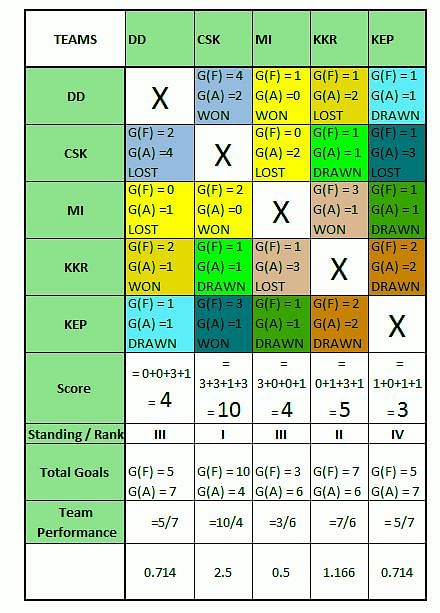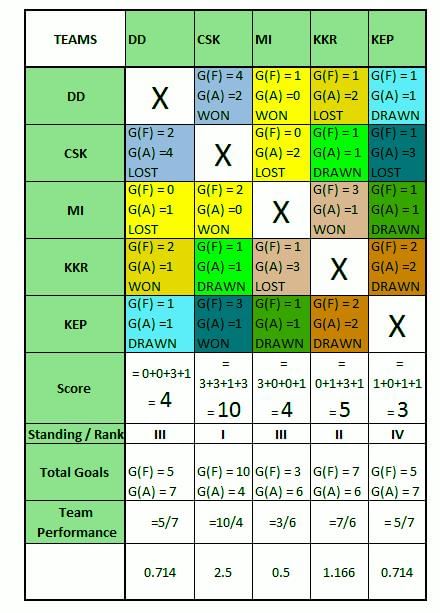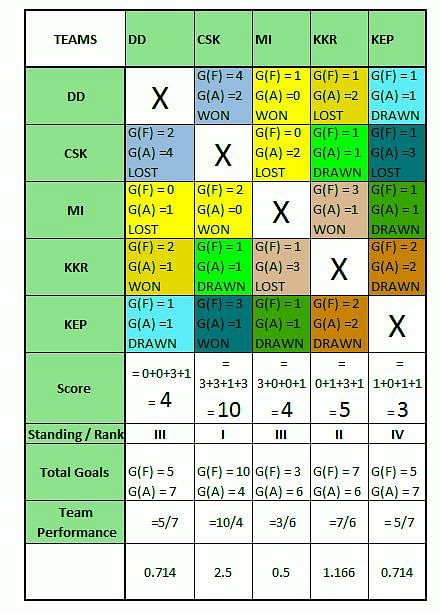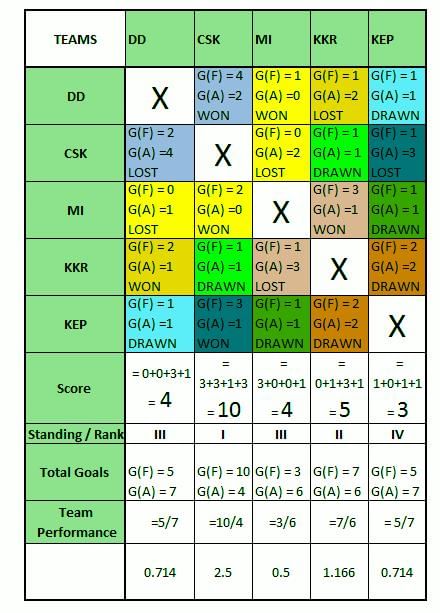CAT Mock Test - 20 (November 22) - CAT MCQ
30 Questions MCQ Test Daily Test for CAT Preparation - CAT Mock Test - 20 (November 22)
Directions: Read the following passage carefully and answer the questions that follow.
Kumaon, the northernmost region of Uttarakhand (a state in India), shines under the Himalayan sun and snow and gushes with water shared with the nation of Nepal. This bond runs thousands of years old, and has only in modern times been obscured by a 225 km border. The traditions of trade and migration - where Kumaoni goods spanned out to Tibet and Central Asia through Nepal, or where Nepalese people dwelling in mountain villages came down to the warmer and more inhabited Kumaon - made the Himalayan range seem less of a geographical barrier and more a home to transnational cultures and incredible religious tolerance.
Though the geographical isolation that the Himalayas brought about could have very easily caused distinction between ethnic and cultural groups and raised barriers to cultural diffusion, the economic and social conditions led to greater tolerance of intermarriage. Parents blessed marriages of couples whose origins were often hundreds of kilometres apart. As a result, love marriages, though not so common, were also accepted in this region, where arranged marriages were usually the norm.
In short, intermarriage and cultural diffusion fuelled each other across the Indo-Nepalese border. The traditions of both regions, which are neither "purely" from those regions, emphasize this fact. Hindus in Kumaon are less preoccupied with the caste system (though there is still discrimination that exists as a result of this hierarchy.) Buddhists in Nepal retain certain elements of Hinduism that were left with them even as the last of the Kumaoni migrant traders passed by their villages.
However, following British rule in India, the Anglo-Nepalese war, and the creation of geopolitical entities, the 225 km landscape which was once known as an open gate between kingdoms of India and Nepal became an established border. Centuries of open trade and intermarriage became closed off, and those who once lived within an autonomous Kumaon with its own kingdom and culture became, for the first time, to be known as Indians.
Even today, marriages take place across the border, and thus hold together ancient ties between families and different cultural and ethnic groups. For example, Nepalese men leave their homes for Kumaon in search of jobs and even the love of their life. Immigration between Nepal and India has extremely lax regulations - about 18 forms of ID are acceptable for passing through the border. Even if one cannot produce such ID, get permission, or get a fake passport (another common options) many Nepalese can still take advantage of obscure but dangerous pedestrian paths and cross rivers to get to the land that was once bound with theirs.
Once in the Kumaon region, Nepalese migrants usually work menial jobs and, in glaring contrast to their ancestors, are given the short end of the stick in terms of the social hierarchy. Not only are they looked down upon by many modern-day Kumaonis who consider themselves more Indian than Himalayan (though it merits mention that many Kumaonis still venerate the ancient ties with Nepal) but they also face their business often face crushing competitions from larger businesses with backing from Indian financial institutions.
This is further emphasized when one looks at the implications of many Indians immigrating freely into Nepal. The Nepalese government has complained time and again about migrant Indians luring Nepalese women into prostitution with empty promises of Bollywood and glamour. In addition, Indian dacoits (robbers or bandits) often take advantage of the porous border and spill into southern and western Nepal. In short, the tie is there, but it is not what it used to be.
Q. Which of the following options best sums up the central idea of the passage?
Directions: Read the following passage carefully and answer the questions that follow.
Kumaon, the northernmost region of Uttarakhand (a state in India), shines under the Himalayan sun and snow and gushes with water shared with the nation of Nepal. This bond runs thousands of years old, and has only in modern times been obscured by a 225 km border. The traditions of trade and migration - where Kumaoni goods spanned out to Tibet and Central Asia through Nepal, or where Nepalese people dwelling in mountain villages came down to the warmer and more inhabited Kumaon - made the Himalayan range seem less of a geographical barrier and more a home to transnational cultures and incredible religious tolerance.
Though the geographical isolation that the Himalayas brought about could have very easily caused distinction between ethnic and cultural groups and raised barriers to cultural diffusion, the economic and social conditions led to greater tolerance of intermarriage. Parents blessed marriages of couples whose origins were often hundreds of kilometres apart. As a result, love marriages, though not so common, were also accepted in this region, where arranged marriages were usually the norm.
In short, intermarriage and cultural diffusion fuelled each other across the Indo-Nepalese border. The traditions of both regions, which are neither "purely" from those regions, emphasize this fact. Hindus in Kumaon are less preoccupied with the caste system (though there is still discrimination that exists as a result of this hierarchy.) Buddhists in Nepal retain certain elements of Hinduism that were left with them even as the last of the Kumaoni migrant traders passed by their villages.
However, following British rule in India, the Anglo-Nepalese war, and the creation of geopolitical entities, the 225 km landscape which was once known as an open gate between kingdoms of India and Nepal became an established border. Centuries of open trade and intermarriage became closed off, and those who once lived within an autonomous Kumaon with its own kingdom and culture became, for the first time, to be known as Indians.
Even today, marriages take place across the border, and thus hold together ancient ties between families and different cultural and ethnic groups. For example, Nepalese men leave their homes for Kumaon in search of jobs and even the love of their life. Immigration between Nepal and India has extremely lax regulations - about 18 forms of ID are acceptable for passing through the border. Even if one cannot produce such ID, get permission, or get a fake passport (another common options) many Nepalese can still take advantage of obscure but dangerous pedestrian paths and cross rivers to get to the land that was once bound with theirs.
Once in the Kumaon region, Nepalese migrants usually work menial jobs and, in glaring contrast to their ancestors, are given the short end of the stick in terms of the social hierarchy. Not only are they looked down upon by many modern-day Kumaonis who consider themselves more Indian than Himalayan (though it merits mention that many Kumaonis still venerate the ancient ties with Nepal) but they also face their business often face crushing competitions from larger businesses with backing from Indian financial institutions.
This is further emphasized when one looks at the implications of many Indians immigrating freely into Nepal. The Nepalese government has complained time and again about migrant Indians luring Nepalese women into prostitution with empty promises of Bollywood and glamour. In addition, Indian dacoits (robbers or bandits) often take advantage of the porous border and spill into southern and western Nepal. In short, the tie is there, but it is not what it used to be.
Q. It can be understood that in the fourth paragraph, the key purpose of the author is to:
Directions: Read the following passage carefully and answer the questions that follow.
Kumaon, the northernmost region of Uttarakhand (a state in India), shines under the Himalayan sun and snow and gushes with water shared with the nation of Nepal. This bond runs thousands of years old, and has only in modern times been obscured by a 225 km border. The traditions of trade and migration - where Kumaoni goods spanned out to Tibet and Central Asia through Nepal, or where Nepalese people dwelling in mountain villages came down to the warmer and more inhabited Kumaon - made the Himalayan range seem less of a geographical barrier and more a home to transnational cultures and incredible religious tolerance.
Though the geographical isolation that the Himalayas brought about could have very easily caused distinction between ethnic and cultural groups and raised barriers to cultural diffusion, the economic and social conditions led to greater tolerance of intermarriage. Parents blessed marriages of couples whose origins were often hundreds of kilometres apart. As a result, love marriages, though not so common, were also accepted in this region, where arranged marriages were usually the norm.
In short, intermarriage and cultural diffusion fuelled each other across the Indo-Nepalese border. The traditions of both regions, which are neither "purely" from those regions, emphasize this fact. Hindus in Kumaon are less preoccupied with the caste system (though there is still discrimination that exists as a result of this hierarchy.) Buddhists in Nepal retain certain elements of Hinduism that were left with them even as the last of the Kumaoni migrant traders passed by their villages.
However, following British rule in India, the Anglo-Nepalese war, and the creation of geopolitical entities, the 225 km landscape which was once known as an open gate between kingdoms of India and Nepal became an established border. Centuries of open trade and intermarriage became closed off, and those who once lived within an autonomous Kumaon with its own kingdom and culture became, for the first time, to be known as Indians.
Even today, marriages take place across the border, and thus hold together ancient ties between families and different cultural and ethnic groups. For example, Nepalese men leave their homes for Kumaon in search of jobs and even the love of their life. Immigration between Nepal and India has extremely lax regulations - about 18 forms of ID are acceptable for passing through the border. Even if one cannot produce such ID, get permission, or get a fake passport (another common options) many Nepalese can still take advantage of obscure but dangerous pedestrian paths and cross rivers to get to the land that was once bound with theirs.
Once in the Kumaon region, Nepalese migrants usually work menial jobs and, in glaring contrast to their ancestors, are given the short end of the stick in terms of the social hierarchy. Not only are they looked down upon by many modern-day Kumaonis who consider themselves more Indian than Himalayan (though it merits mention that many Kumaonis still venerate the ancient ties with Nepal) but they also face their business often face crushing competitions from larger businesses with backing from Indian financial institutions.
This is further emphasized when one looks at the implications of many Indians immigrating freely into Nepal. The Nepalese government has complained time and again about migrant Indians luring Nepalese women into prostitution with empty promises of Bollywood and glamour. In addition, Indian dacoits (robbers or bandits) often take advantage of the porous border and spill into southern and western Nepal. In short, the tie is there, but it is not what it used to be.
Q. It can be understood from the context of the passage that which of the following would seamlessly follow the last paragraph?
Directions: Read the following passage carefully and answer the given question.
It took me some time to notice where this process of elimination was leading me. For example, as I once found myself arguing, the state of Michigan has a provision in its founding constitution that forbids capital punishment. Yet high as the rate of violent crime is in Michigan, it is not noticeably worse than in neighboring and somewhat comparable Illinois. Thus, as I was going on to argue, there is no reason to suppose that the death penalty is a deterrent. And then it hit me. I had been hammering on an open door. Nobody had been bothering to argue that the rope or the firing squad, or the gas chamber were a deterrent. The point of the penalty was that it was death. It expressed righteous revulsion and symbolized rectitude and retribution.
Once we clear away the brush, then, we can see the crystalline purity of the principle of an eye for an eye. I used to debate these questions with the late Professor Ernest van den Haag. In the case of an execution of an innocent person, he once said to me, the necessary point had nonetheless been made: the state and the community had shown that they were prepared to kill. It did not especially matter if they had or had not taken the "right" life. I found, and find, van den Haag's position to be entirely repellent, and I am not alone. At an execution I attended in 1987 at the Parchman Prison Farm in Mississippi, the guilt of the condemned man was so uncertain that the warden later resigned from his job in horror and disgust. But if one is to lay stress on such cases, then one is morally obliged to consider the approximate equivalents. How might you feel if a friend or loved one was to be murdered by a criminal who had killed before but who had been released prematurely? How might you feel if an inmate or a guard was slain by someone who had been sentenced to life without parole? In these cases, a crisp and swift application of the death penalty would have saved lives. The beast-man is then apprehended.
Here, I think, we come up against the old problem of perfectibility and predictability. We cannot know in advance which malefactor, pre-emptively terminated, might have become a repeat offender. Nor can we know, until we set up a "pre-crime" system of detection, which pedophile might in other ways turn out to be a psychopath. So it isn't in our power to save the second category of lives unless we agree to execute all murderers and child rapists. But it is possible to eliminate the execution of the innocent, simply by joining the association of countries that have dispensed with the death penalty.
In a modern state that allows for appeals, judicial review, and the admission of new evidence, the death sentence is only the beginning of a protracted and tortuous process to which we give the apotropaic name of "Death Row." At once too random and too institutional and systematic, this dire business has now become an offense both to law and to justice.
Q. Which of the following can be best inferred from the statement ''It did not especially matter if they had or had not taken the 'right' life''?
Directions: Read the following passage carefully and answer the given question.
It took me some time to notice where this process of elimination was leading me. For example, as I once found myself arguing, the state of Michigan has a provision in its founding constitution that forbids capital punishment. Yet high as the rate of violent crime is in Michigan, it is not noticeably worse than in neighboring and somewhat comparable Illinois. Thus, as I was going on to argue, there is no reason to suppose that the death penalty is a deterrent. And then it hit me. I had been hammering on an open door. Nobody had been bothering to argue that the rope or the firing squad, or the gas chamber were a deterrent. The point of the penalty was that it was death. It expressed righteous revulsion and symbolized rectitude and retribution.
Once we clear away the brush, then, we can see the crystalline purity of the principle of an eye for an eye. I used to debate these questions with the late Professor Ernest van den Haag. In the case of an execution of an innocent person, he once said to me, the necessary point had nonetheless been made: the state and the community had shown that they were prepared to kill. It did not especially matter if they had or had not taken the "right" life. I found, and find, van den Haag's position to be entirely repellent, and I am not alone. At an execution I attended in 1987 at the Parchman Prison Farm in Mississippi, the guilt of the condemned man was so uncertain that the warden later resigned from his job in horror and disgust. But if one is to lay stress on such cases, then one is morally obliged to consider the approximate equivalents. How might you feel if a friend or loved one was to be murdered by a criminal who had killed before but who had been released prematurely? How might you feel if an inmate or a guard was slain by someone who had been sentenced to life without parole? In these cases, a crisp and swift application of the death penalty would have saved lives. The beast-man is then apprehended.
Here, I think, we come up against the old problem of perfectibility and predictability. We cannot know in advance which malefactor, pre-emptively terminated, might have become a repeat offender. Nor can we know, until we set up a "pre-crime" system of detection, which pedophile might in other ways turn out to be a psychopath. So it isn't in our power to save the second category of lives unless we agree to execute all murderers and child rapists. But it is possible to eliminate the execution of the innocent, simply by joining the association of countries that have dispensed with the death penalty.
In a modern state that allows for appeals, judicial review, and the admission of new evidence, the death sentence is only the beginning of a protracted and tortuous process to which we give the apotropaic name of "Death Row." At once too random and too institutional and systematic, this dire business has now become an offense both to law and to justice.
Q. On the basis of the information given in the passage, it can be inferred that the author is most likely to agree with which of the following statements?
Directions: Read the following passage carefully and answer the given question.
It took me some time to notice where this process of elimination was leading me. For example, as I once found myself arguing, the state of Michigan has a provision in its founding constitution that forbids capital punishment. Yet high as the rate of violent crime is in Michigan, it is not noticeably worse than in neighboring and somewhat comparable Illinois. Thus, as I was going on to argue, there is no reason to suppose that the death penalty is a deterrent. And then it hit me. I had been hammering on an open door. Nobody had been bothering to argue that the rope or the firing squad, or the gas chamber were a deterrent. The point of the penalty was that it was death. It expressed righteous revulsion and symbolized rectitude and retribution.
Once we clear away the brush, then, we can see the crystalline purity of the principle of an eye for an eye. I used to debate these questions with the late Professor Ernest van den Haag. In the case of an execution of an innocent person, he once said to me, the necessary point had nonetheless been made: the state and the community had shown that they were prepared to kill. It did not especially matter if they had or had not taken the "right" life. I found, and find, van den Haag's position to be entirely repellent, and I am not alone. At an execution I attended in 1987 at the Parchman Prison Farm in Mississippi, the guilt of the condemned man was so uncertain that the warden later resigned from his job in horror and disgust. But if one is to lay stress on such cases, then one is morally obliged to consider the approximate equivalents. How might you feel if a friend or loved one was to be murdered by a criminal who had killed before but who had been released prematurely? How might you feel if an inmate or a guard was slain by someone who had been sentenced to life without parole? In these cases, a crisp and swift application of the death penalty would have saved lives. The beast-man is then apprehended.
Here, I think, we come up against the old problem of perfectibility and predictability. We cannot know in advance which malefactor, pre-emptively terminated, might have become a repeat offender. Nor can we know, until we set up a "pre-crime" system of detection, which pedophile might in other ways turn out to be a psychopath. So it isn't in our power to save the second category of lives unless we agree to execute all murderers and child rapists. But it is possible to eliminate the execution of the innocent, simply by joining the association of countries that have dispensed with the death penalty.
In a modern state that allows for appeals, judicial review, and the admission of new evidence, the death sentence is only the beginning of a protracted and tortuous process to which we give the apotropaic name of "Death Row." At once too random and too institutional and systematic, this dire business has now become an offense both to law and to justice.
Q. "But if one is to lay stress on such cases, then one is morally obliged to consider the approximate equivalents.'' Which of the following is the author trying to analyse when he states this?
Directions: The four sentences (labelled 1, 2, 3, 4) given below, when properly sequenced would yield a coherent paragraph. Decide on the proper sequence of the order of the sentences and key in the sequence of the four numbers as your answer.
1. The tradition was already ages-old in Japan, but naming it went hand in hand with making recommendations for practices like one should walk, gaze and exercise among the trees and eat well-balanced meals of organic, locally sourced food.
2. How nature can heal was little researched until 1982, when Tomohide Akiyama coined the term 'shinrin-yoku' (forest bathing) to describe the practice of getting into the woods for body and mind renewal.
3. When Akiyama recommended forest bathing all those years ago, he knew about the pioneering studies of phytoncides – basically, pungent essential oils.
4. The oils, volatile compounds exuded by conifers and some other plants, reduce blood pressure and boost immune function, among other benefits.
Directions: There is a sentence that is missing in the paragraph below. Look at the paragraph and decide in which blank (option 1, 2, 3, or 4) the following sentence would best fit.
Sentence: Storm surges and extreme heat can lead to power outages that knock out the technology systems critical to homes, hospitals, and industries.
Paragraph: Cities are on the front lines of the growing physical risks associated with climate change. (1) _______. They are home to more than half of the world's people, and by 2050, that figure is projected to rise to 68 percent. Urban areas are often located in places of particular climate risk, such as on coastlines, floodplains, and islands. (2) _______. Moreover, modern urban infrastructure and its operating systems are closely connected. A failure in one part of a network can affect another, multiplying the damage. (3) _______. Cities must proactively address climate risks and invest in resilient infrastructure to protect their residents and ensure sustainable development for the future. (4) _______.
Directions: There is a sentence that is missing in the paragraph below. Look at the paragraph and decide in which blank (option 1, 2, 3, or 4) the following sentence would best fit.
Sentence: There were no other options.
Paragraph: While traditional banks had been convenient one-stop shops for businesses and consumers, many didn't evolve their products in a way that matched the tech-driven pace of change in other industries. (1) ________. Products such as checking accounts, loans, and even corporate advisory seemed undifferentiated. (2) ________. And people increasingly felt frustrated by the financial fragmentation that banks had imposed on many consumer processes. For instance, buying a home once required navigating a confusing world of disconnected real-estate brokers, mortgage lenders, insurance companies, lawyers, renovation contractors, and so on. (3) ________. Our grandparents tolerated those frustrations, but they also used pay phones. (4) _______. Today, we are awash in new ways to reach and connect with consumers. Banks need to identify and engage these customers—as their newer competitors are doing.
Directions: The passage given below is followed by four alternative summaries. Choose the option that best captures the essence of the passage.
In computer programming, code smell is any symptom in the source code of a programme that possibly indicates a deeper problem. Code smells are usually not bugs - they are not technically incorrect and don't currently prevent the programme from functioning. Instead, they indicate weaknesses in design that may be slowing down development or increasing the risk of bugs or failures in the future. But when code is a slow, wretchedly designed mess that's hard to maintain, programmers talk about stench. The metaphor becomes olfactory, the swill of gases that rise from rot and decay.
Read the passage carefully and answer the questions that follow:
The higher education system is a unique type of organisation with its own way of motivating productivity in its scholarly workforce. It doesn’t need to compel professors to produce scholarship because they choose to do it on their own. This is in contrast to the standard structure for motivating employees in bureaucratic organisations, which relies on manipulating two incentives: fear and greed. Fear works by holding the threat of firing over the heads of workers in order to ensure that they stay in line: Do it my way, or you’re out of here. Greed works by holding the prospect of pay increases and promotions in front of workers in order to encourage them to exhibit the work behaviours that will bring these rewards: Do it my way and you’ll get what’s yours.
Yes, in the United States contingent faculty can be fired at any time, and permanent faculty can be fired at the point of tenure. But, once tenured, there’s little other than criminal conduct or gross negligence that can threaten your job. And yes, most colleges do have merit pay systems that reward more productive faculty with higher salaries. But the differences are small - between the standard 3 per cent raise and a 4 per cent merit increase. Even though gaining consistent above-average raises can compound annually into substantial differences over time, the immediate rewards are pretty underwhelming. Not the kind of incentive that would motivate a major expenditure of effort in a given year - such as the kind that operates on Wall Street, where earning a million-dollar bonus is a real possibility. Academic administrators - chairs, deans, presidents - just don’t have this kind of power over faculty. It’s why we refer to academic leadership as an exercise in herding cats. Deans can ask you to do something, but they really can’t make you do it.
This situation is the norm for systems of higher education in most liberal democracies around the world. In more authoritarian settings, the incentives for faculty are skewed by particular political priorities, and in part, for these reasons, the institutions in those settings tend to be consigned to the lower tiers of international rankings. Scholarly autonomy is a defining characteristic of universities higher on the list.
If the usual extrinsic incentives of fear and greed don’t apply to academics, then what does motivate them to be productive scholars? One factor, of course, is that this population is highly self-selected. People don’t become professors in order to gain power and money. They enter the role primarily because of a deep passion for a particular field of study. They find that scholarship is a mode of work that is intrinsically satisfying. It’s more a vocation than a job. And these elements tend to be pervasive in most of the world’s universities. But I want to focus on an additional powerful motivation that drives academics, one that we don’t talk about very much. Once launched into an academic career, faculty members find their scholarly efforts spurred on by more than a love of the work. We in academia are motivated by a lust for glory.
We want to be recognised for our academic accomplishments by earning our own little pieces of fame. So we work assiduously to accumulate a set of merit badges over the course of our careers, which we then proudly display on our CVs. This situation is particularly pervasive in the US system of higher education, which is organised more by the market than by the state. Market systems are especially prone to the accumulation of distinctions that define your position in the hierarchy. But European and other scholars are also engaged in a race to pick up honours and add lines to their CVs. It’s the universal obsession of the scholarly profession.
Q. According to the passage, more than any other factor, academics are motivated by:
Read the passage carefully and answer the questions that follow:
The higher education system is a unique type of organisation with its own way of motivating productivity in its scholarly workforce. It doesn’t need to compel professors to produce scholarship because they choose to do it on their own. This is in contrast to the standard structure for motivating employees in bureaucratic organisations, which relies on manipulating two incentives: fear and greed. Fear works by holding the threat of firing over the heads of workers in order to ensure that they stay in line: Do it my way, or you’re out of here. Greed works by holding the prospect of pay increases and promotions in front of workers in order to encourage them to exhibit the work behaviours that will bring these rewards: Do it my way and you’ll get what’s yours.
Yes, in the United States contingent faculty can be fired at any time, and permanent faculty can be fired at the point of tenure. But, once tenured, there’s little other than criminal conduct or gross negligence that can threaten your job. And yes, most colleges do have merit pay systems that reward more productive faculty with higher salaries. But the differences are small - between the standard 3 per cent raise and a 4 per cent merit increase. Even though gaining consistent above-average raises can compound annually into substantial differences over time, the immediate rewards are pretty underwhelming. Not the kind of incentive that would motivate a major expenditure of effort in a given year - such as the kind that operates on Wall Street, where earning a million-dollar bonus is a real possibility. Academic administrators - chairs, deans, presidents - just don’t have this kind of power over faculty. It’s why we refer to academic leadership as an exercise in herding cats. Deans can ask you to do something, but they really can’t make you do it.
This situation is the norm for systems of higher education in most liberal democracies around the world. In more authoritarian settings, the incentives for faculty are skewed by particular political priorities, and in part, for these reasons, the institutions in those settings tend to be consigned to the lower tiers of international rankings. Scholarly autonomy is a defining characteristic of universities higher on the list.
If the usual extrinsic incentives of fear and greed don’t apply to academics, then what does motivate them to be productive scholars? One factor, of course, is that this population is highly self-selected. People don’t become professors in order to gain power and money. They enter the role primarily because of a deep passion for a particular field of study. They find that scholarship is a mode of work that is intrinsically satisfying. It’s more a vocation than a job. And these elements tend to be pervasive in most of the world’s universities. But I want to focus on an additional powerful motivation that drives academics, one that we don’t talk about very much. Once launched into an academic career, faculty members find their scholarly efforts spurred on by more than a love of the work. We in academia are motivated by a lust for glory.
We want to be recognised for our academic accomplishments by earning our own little pieces of fame. So we work assiduously to accumulate a set of merit badges over the course of our careers, which we then proudly display on our CVs. This situation is particularly pervasive in the US system of higher education, which is organised more by the market than by the state. Market systems are especially prone to the accumulation of distinctions that define your position in the hierarchy. But European and other scholars are also engaged in a race to pick up honours and add lines to their CVs. It’s the universal obsession of the scholarly profession.
Q. Which of the following, if true, would do most to undermine the main point of the second paragraph?
Read the passage and answer the following questions.
Publishing the Quran and making it available in translation was a dangerous enterprise in the 16th century, apt to confuse or seduce the faithful Christian. This, at least, was the opinion of the Protestant city councillors of Basel in 1542, when they briefly jailed a local printer for planning to publish a Latin translation of the Muslim holy book. The Protestant reformer Martin Luther intervened to salvage the project: there was no better way to combat the Turk, he wrote, than to expose the ‘lies of Muhammad’ for all to see.
The resulting publication in 1543 made the Quran available to European intellectuals, most of whom studied it in order to better understand and combat Islam. There were others, however, who used their reading of the Quran to question Christian doctrine. The Catalonian polymath and theologian Michael Servetus found numerous Quranic arguments to employ in his anti-Trinitarian tract, Christianismi Restitutio (1553), in which he called Muhammad a true reformer who preached a return to the pure monotheism that Christian theologians had corrupted by inventing the perverse and irrational doctrine of the Trinity. After publishing these heretical ideas, Servetus was condemned by the Catholic Inquisition in Vienne, and finally burned with his own books in Calvin’s Geneva.
During the European Enlightenment, a number of authors presented Muhammad in a similar vein, as an anticlerical hero; some saw Islam as a pure form of monotheism close to philosophic Deism and the Quran as a rational paean to the Creator. In 1734, George Sale published a new English translation. In his introduction, he traced the early history of Islam and idealised the Prophet as an iconoclastic, anticlerical reformer who had banished the ‘superstitious’ beliefs and practices of early Christians - the cult of the saints, holy relics - and quashed the power of a corrupt and avaricious clergy.
Sale’s translation of the Quran was widely read and appreciated in England: for many of his readers, Muhammad had become a symbol of anticlerical republicanism. It was influential outside England too. The US founding father Thomas Jefferson bought a copy from a bookseller in Williamsburg, Virginia, in 1765, which helped him conceive of a philosophical deism that surpassed confessional boundaries. (Jefferson’s copy, now in the Library of Congress, has been used for the swearing in of Muslim representatives to Congress, starting with Keith Ellison in 2007.) And in Germany, the Romantic Johann Wolfgang von Goethe read a translation of Sale’s version, which helped to colour his evolving notion of Muhammad as an inspired poet and archetypal prophet.
Q. What is the purpose of the penultimate paragraph?
Directions: Study the following information carefully and answer the question.
In a research study conducted in 2002, a team of scientists embarked on a mission to investigate the impact of air pollution on respiratory health. They carefully selected a diverse group of 1600 participants, comprising 800 males and 800 females, to participate in the study. The study aimed to monitor their respiratory health for a duration of 5 years, tracking death caused by any respiratory-related conditions or ailments that developed during this period. To ensure representation across various age groups, the 800 male participants were categorised into four distinct age brackets: 200 individuals between the ages of 15 and less than 30, 200 between 30 and less than 45, 200 between 45 and less than 60, and another 200 between 60 and less than 75. Similarly, the 800 female participants were equally divided into the same age groups. Over the course of the study, data was collected at specific intervals to analyse the alive participants' respiratory health. Specifically, assessments were conducted in the years 2007, 2012, 2017, and 2022. The findings were visually depicted in graphs.
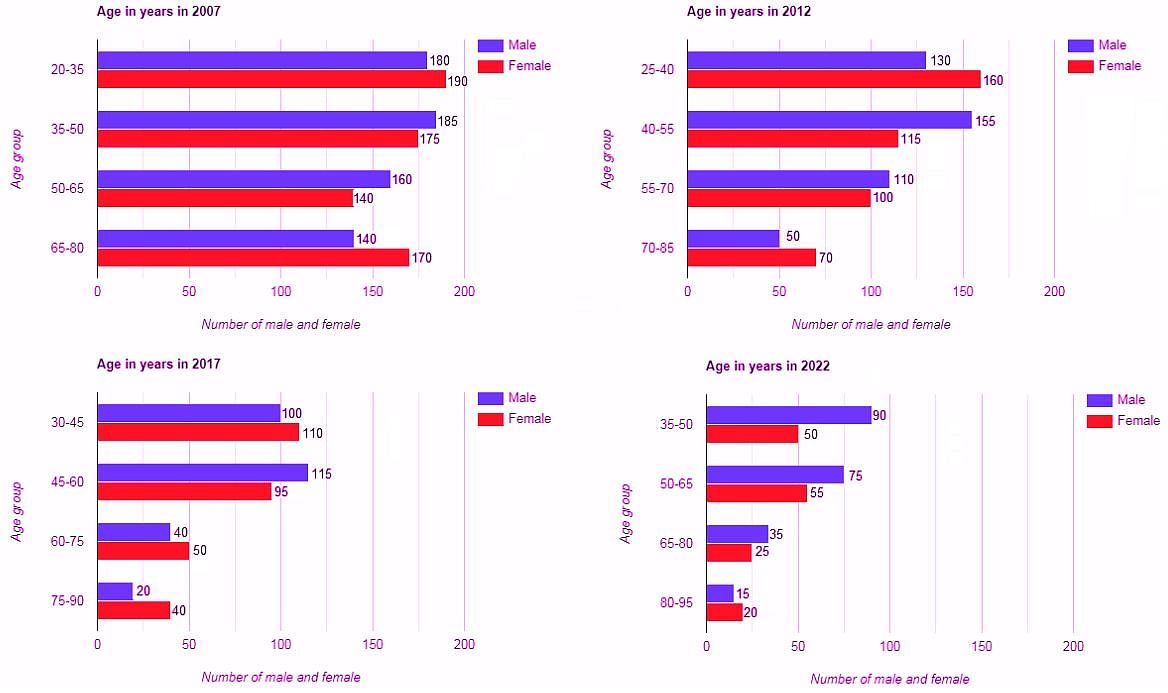
Q. Find the number of females in the age group 20-35 in 2007 who died between 2012 and 2017.
Directions: Study the following information carefully and answer the question.
In a research study conducted in 2002, a team of scientists embarked on a mission to investigate the impact of air pollution on respiratory health. They carefully selected a diverse group of 1600 participants, comprising 800 males and 800 females, to participate in the study. The study aimed to monitor their respiratory health for a duration of 5 years, tracking death caused by any respiratory-related conditions or ailments that developed during this period. To ensure representation across various age groups, the 800 male participants were categorised into four distinct age brackets: 200 individuals between the ages of 15 and less than 30, 200 between 30 and less than 45, 200 between 45 and less than 60, and another 200 between 60 and less than 75. Similarly, the 800 female participants were equally divided into the same age groups. Over the course of the study, data was collected at specific intervals to analyse the alive participants' respiratory health. Specifically, assessments were conducted in the years 2007, 2012, 2017, and 2022. The findings were visually depicted in graphs.
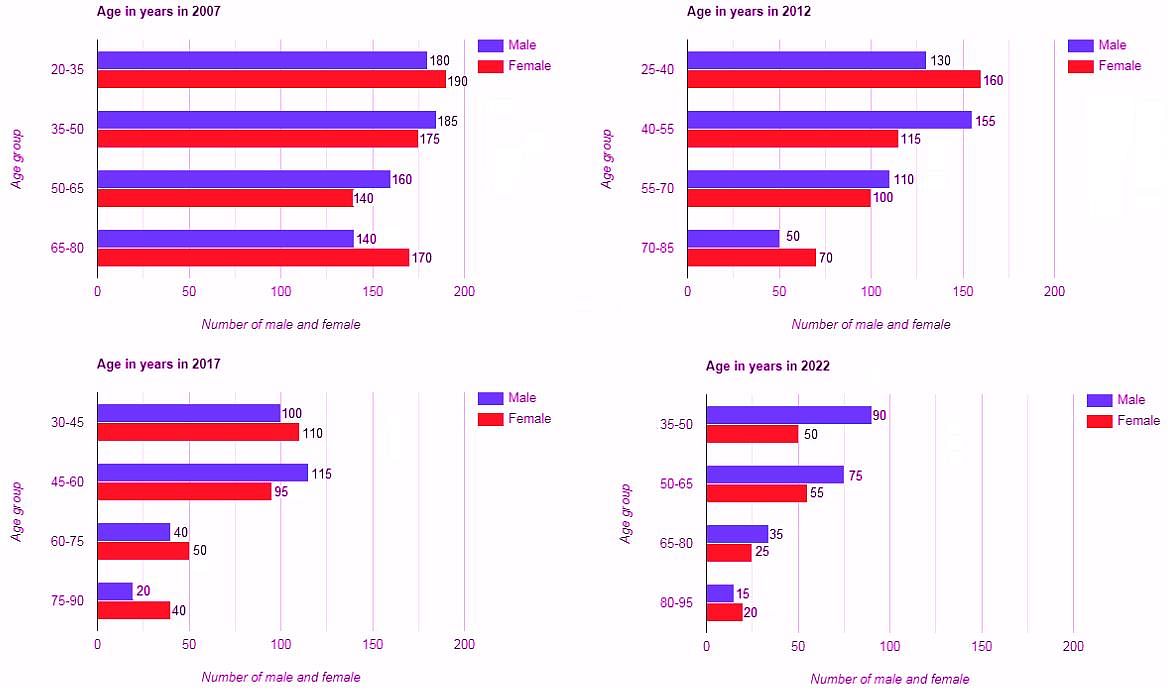
Q. What is the ratio of the number of dead males to that of dead females in 2012?
Directions: Study the following information carefully and answer the question.
In a research study conducted in 2002, a team of scientists embarked on a mission to investigate the impact of air pollution on respiratory health. They carefully selected a diverse group of 1600 participants, comprising 800 males and 800 females, to participate in the study. The study aimed to monitor their respiratory health for a duration of 5 years, tracking death caused by any respiratory-related conditions or ailments that developed during this period. To ensure representation across various age groups, the 800 male participants were categorised into four distinct age brackets: 200 individuals between the ages of 15 and less than 30, 200 between 30 and less than 45, 200 between 45 and less than 60, and another 200 between 60 and less than 75. Similarly, the 800 female participants were equally divided into the same age groups. Over the course of the study, data was collected at specific intervals to analyse the alive participants' respiratory health. Specifically, assessments were conducted in the years 2007, 2012, 2017, and 2022. The findings were visually depicted in graphs.
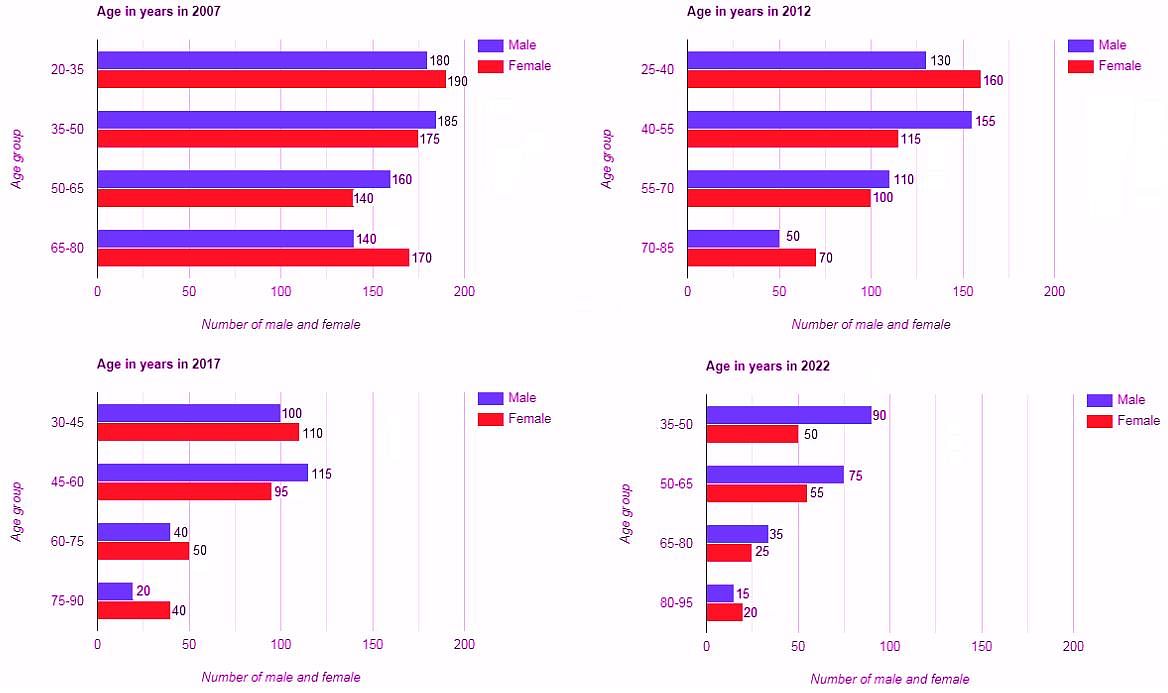
Q. What is the difference between the number of males and the number of females in 2017?
Directions: Study the following information carefully and answer the question.
In a research study conducted in 2002, a team of scientists embarked on a mission to investigate the impact of air pollution on respiratory health. They carefully selected a diverse group of 1600 participants, comprising 800 males and 800 females, to participate in the study. The study aimed to monitor their respiratory health for a duration of 5 years, tracking death caused by any respiratory-related conditions or ailments that developed during this period. To ensure representation across various age groups, the 800 male participants were categorised into four distinct age brackets: 200 individuals between the ages of 15 and less than 30, 200 between 30 and less than 45, 200 between 45 and less than 60, and another 200 between 60 and less than 75. Similarly, the 800 female participants were equally divided into the same age groups. Over the course of the study, data was collected at specific intervals to analyse the alive participants' respiratory health. Specifically, assessments were conducted in the years 2007, 2012, 2017, and 2022. The findings were visually depicted in graphs.
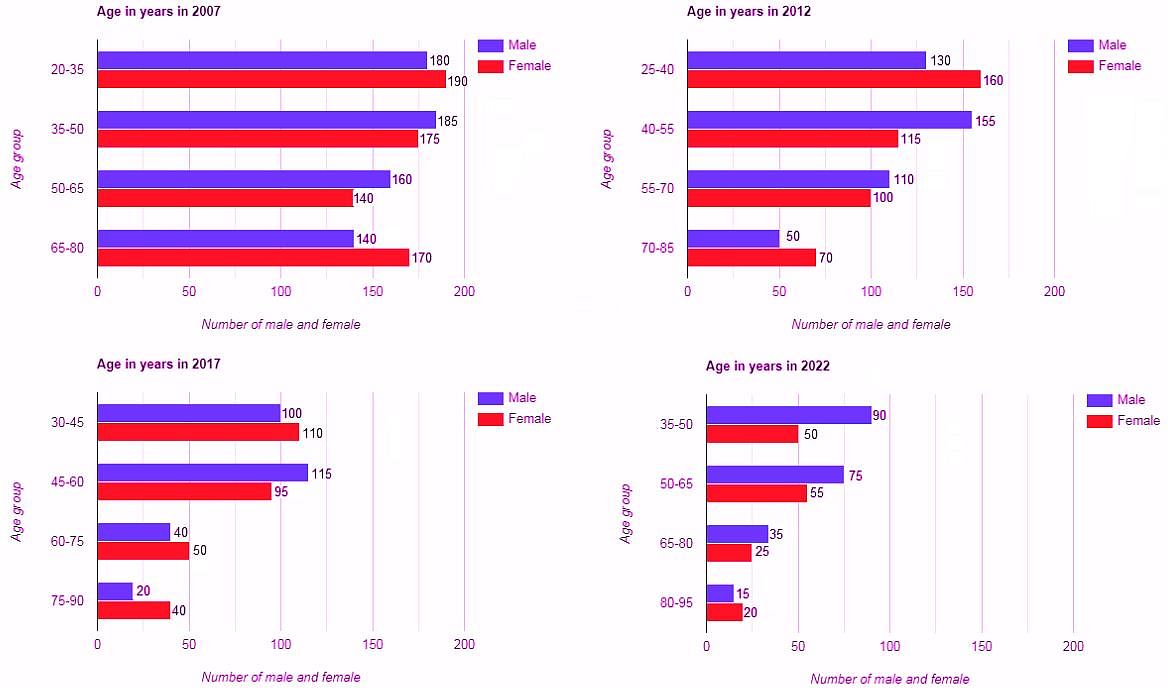
Q. Find the number of people who participated in the investigation and died before 2022.
Directions: Study the given information and answer the question that follows.
In a high school, students have the option to choose two elective courses: Photography and Music. All students in the Art Department are required to take both courses, while students from other departments can select one of the two options. Grades are given based on performance with A, B and C representing different levels of achievement and F for failure. Consider the following additional information about the number of students who took these courses this year and the grades they obtained:
(i) The ratio of the number of non-Art Department students who chose Photography to that of those who chose Music was 3 : 4.
(ii) The total number of non-Art Department students who took either Photography or Music was equal to the number of Art Department students.
(iii) The number of non-Art Department students who failed in both Photography and Music courses was the same, and this total was equivalent to the number of Art Department students who received grade C in Music.
(iv) Among the students who passed Music courses, 60% achieved grade B. However, while the numbers of students who received grades A and C were equal for Photography, the ratio for Music was 24 : 7.
(v) No Art Department student failed in the Photography course, and no non-Art Department student received grade A in Photography.
(vi) The ratio of the numbers of Art Department students who received grades A, B and C in Photography was 3 : 5 : 2, while for Music, the ratio was 4 : 5 : 1.
(vii) The ratio of the total number of non-Art Department students failing in either of the two courses to the number of Art Department students failing in either of the two courses was 2 : 1.
(viii) A total of 20 students failed in the Music course.
Q. What is the number of non-Art Music students who got grade A? Key in the number.
Directions: Study the given information and answer the question that follows.
In a high school, students have the option to choose two elective courses: Photography and Music. All students in the Art Department are required to take both courses, while students from other departments can select one of the two options. Grades are given based on performance with A, B and C representing different levels of achievement and F for failure. Consider the following additional information about the number of students who took these courses this year and the grades they obtained:
(i) The ratio of the number of non-Art Department students who chose Photography to that of those who chose Music was 3 : 4.
(ii) The total number of non-Art Department students who took either Photography or Music was equal to the number of Art Department students.
(iii) The number of non-Art Department students who failed in both Photography and Music courses was the same, and this total was equivalent to the number of Art Department students who received grade C in Music.
(iv) Among the students who passed Music courses, 60% achieved grade B. However, while the numbers of students who received grades A and C were equal for Photography, the ratio for Music was 24 : 7.
(v) No Art Department student failed in the Photography course, and no non-Art Department student received grade A in Photography.
(vi) The ratio of the numbers of Art Department students who received grades A, B and C in Photography was 3 : 5 : 2, while for Music, the ratio was 4 : 5 : 1.
(vii) The ratio of the total number of non-Art Department students failing in either of the two courses to the number of Art Department students failing in either of the two courses was 2 : 1.
(viii) A total of 20 students failed in the Music course.
Q. What is the total number of students who got grade B?
Directions: Study the given information and answer the question that follows.
In a high school, students have the option to choose two elective courses: Photography and Music. All students in the Art Department are required to take both courses, while students from other departments can select one of the two options. Grades are given based on performance with A, B and C representing different levels of achievement and F for failure. Consider the following additional information about the number of students who took these courses this year and the grades they obtained:
(i) The ratio of the number of non-Art Department students who chose Photography to that of those who chose Music was 3 : 4.
(ii) The total number of non-Art Department students who took either Photography or Music was equal to the number of Art Department students.
(iii) The number of non-Art Department students who failed in both Photography and Music courses was the same, and this total was equivalent to the number of Art Department students who received grade C in Music.
(iv) Among the students who passed Music courses, 60% achieved grade B. However, while the numbers of students who received grades A and C were equal for Photography, the ratio for Music was 24 : 7.
(v) No Art Department student failed in the Photography course, and no non-Art Department student received grade A in Photography.
(vi) The ratio of the numbers of Art Department students who received grades A, B and C in Photography was 3 : 5 : 2, while for Music, the ratio was 4 : 5 : 1.
(vii) The ratio of the total number of non-Art Department students failing in either of the two courses to the number of Art Department students failing in either of the two courses was 2 : 1.
(viii) A total of 20 students failed in the Music course.
Q. How many Art students passed the Music course? Key in the number.
Directions: Answer the given question based on the following data.
There were five teams in a hockey tournament: Delhi Daredevils, Chennai Superkings, Mumbai Indians, Kolkata Knight Riders and Kings Eleven Punjab. The tournament was played as a round robin league where each team played with other teams exactly twice on a home and away basis. The following table gives the information about the results of the matches in the first leg of the tournament:
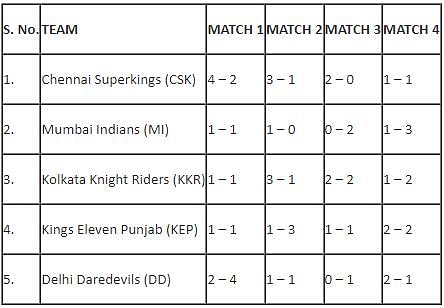
Here, Chennai Superkings 4-2 means Chennai Superkings scored 4 goals and the other team scored 2 goals.
The winning team gets 3 points and if the game is a draw, then both the teams get 1 point each. Losing team does not get any point. The team with highest number of points at the end of the tournament wins the cup.
Team performance ratio is defined as the ratio of the number of goals for to the number of goals against. Lesser the performance ratio, lower is the performance.
Q. The only match which KEP lost was with
Directions: Answer the given question based on the following data.
There were five teams in a hockey tournament: Delhi Daredevils, Chennai Superkings, Mumbai Indians, Kolkata Knight Riders and Kings Eleven Punjab. The tournament was played as a round robin league where each team played with other teams exactly twice on a home and away basis. The following table gives the information about the results of the matches in the first leg of the tournament:
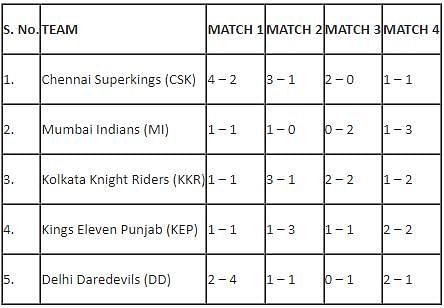
Here, Chennai Superkings 4-2 means Chennai Superkings scored 4 goals and the other team scored 2 goals.
The winning team gets 3 points and if the game is a draw, then both the teams get 1 point each. Losing team does not get any point. The team with highest number of points at the end of the tournament wins the cup.
Team performance ratio is defined as the ratio of the number of goals for to the number of goals against. Lesser the performance ratio, lower is the performance.
Q. In the second leg of the tournament, what was the minimum number of matches required to be played in order for the team second in standings, to overtake the 1st ranked team?
Directions: Answer the given question based on the following data.
There were five teams in a hockey tournament: Delhi Daredevils, Chennai Superkings, Mumbai Indians, Kolkata Knight Riders and Kings Eleven Punjab. The tournament was played as a round robin league where each team played with other teams exactly twice on a home and away basis. The following table gives the information about the results of the matches in the first leg of the tournament:
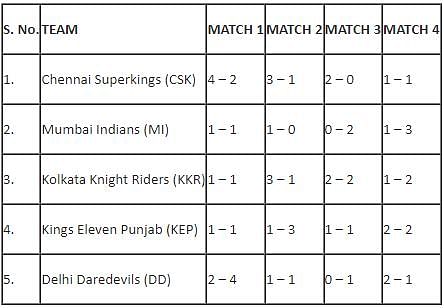
Here, Chennai Superkings 4-2 means Chennai Superkings scored 4 goals and the other team scored 2 goals.
The winning team gets 3 points and if the game is a draw, then both the teams get 1 point each. Losing team does not get any point. The team with highest number of points at the end of the tournament wins the cup.
Team performance ratio is defined as the ratio of the number of goals for to the number of goals against. Lesser the performance ratio, lower is the performance.
Q. What is the difference in the performance ratio between the highest and the lowest performance?
Directions: Answer the given question based on the following data.
There were five teams in a hockey tournament: Delhi Daredevils, Chennai Superkings, Mumbai Indians, Kolkata Knight Riders and Kings Eleven Punjab. The tournament was played as a round robin league where each team played with other teams exactly twice on a home and away basis. The following table gives the information about the results of the matches in the first leg of the tournament:
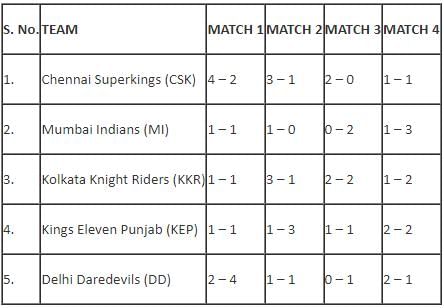
Here, Chennai Superkings 4-2 means Chennai Superkings scored 4 goals and the other team scored 2 goals.
The winning team gets 3 points and if the game is a draw, then both the teams get 1 point each. Losing team does not get any point. The team with highest number of points at the end of the tournament wins the cup.
Team performance ratio is defined as the ratio of the number of goals for to the number of goals against. Lesser the performance ratio, lower is the performance.
Q. Which of the following is correct?
Ram borrowed Rs 72000 at 20% p.a compound interest, the interest being compounded annually. He repaid x at the end of the first year and 57600 at the end of the second year and he cleared the loan. The amount he paid at the end of the first year was.
Let us assume we have an eight face die numbered from 1 to 8. What is the probability that exactly two of the eight numbers appear on the top face in the five throws of an unbiased die?
A pair of straight lines is expressed as 2x2 - 3 = 0. The straight lines are ____________ to each other. Fill in the blank.
Aruj can fill a large tank from a river with a bucket in 40 minutes, Anik is 25% more efficient than Aruj and Rhitam is 20% more efficient than Anik. Aruj and Anik are allotted for filling up the tank. Rhitam, being a naughty kid, starts emptying the tank. Assuming filling the tank requires equal time and effort as that for emptying, what is the time required to fill the tank?
Banta Singh was driving to Lonawala when his truck suddenly stops. He realised that the truck has run out of diesel, He remembered that he has a can holding 'P' liters of diesel and promptly emptied it into the right circular cylindrical diesel tank. He then inserted a straight stick vertically into the tank such that the free end of stick touches the bottom of the tank. He found that E% of stick left dry. After traveling a few kilometers (for which fuel consumption is negligible), he reached a refueling station. Now how many litres of diesel will be needed to fill the diesel tank of Banta's truck?
Three small scale industries K, L and M invested in a business. The overall profit earned from the investment is shared among K, L and M in proportion to their investment. K has 40% share in the investment. If the overall profit goes down by 5% from 12%, he loses Rs. 80,000 from his share of profit. M's share of profit increases by Rs. 12,000 if the overall profit goes up by 3% from 7%. What proportion of the total investment belonged to L? Key in the percentage value.
|
152 docs|327 tests
|
























































